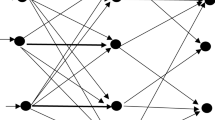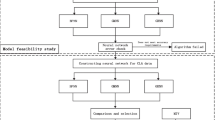Abstract
The rationality of regional land planning needs to be evaluated through intelligent technology and continuously optimized. At present, most land planning is temporarily adjusted according to actual needs, so it does not have real-time dynamics. In order to improve the rationality of regional land planning, based on BP neural network, this study combined the spatial mining technology to construct a regional land planning model, and used BP neural network and SVM technology to establish a relationship model between the impact factor value and distance scale factor. Moreover, based on the gray system theory, this study uses the gray correlation model to measure the coupling degree between industrial structure and land use, and analyzes the correlation between various factors. In addition, the artificial neural network after learning and testing can be used for dynamic simulation calculations. The research results show that this algorithm has some practical effects.


















Similar content being viewed by others
References
Lee J, Newman G (2017) Forecasting urban vacancy dynamics in a shrinking city: a land transformation model. Int J Geo-Inf 6(4):124–132
Neylon J, Min Y, Low DA et al (2017) A neural network approach for fast, automated quantification of DIR performance. Med Phys 44(8):4126–4138
Sabattini JA, Sabattini RA, Urteaga-Omar AF et al (2019) Classification of successional stages in native forests of the Argentine Spinal through neural networks. Land Degrad Dev 30(17):2064–2072
Manaf SA, Mustapha N, Sulaiman M et al (2018) Artificial neural networks for satellite image classification of shoreline extraction for land and water classes of the North West Coast of Peninsular Malaysia. Adv Sci Lett 24(2):1382–1387
Ishida K, Shimokawa T, Hamasaki Y et al (2014) 2P230 Characterization of the olfactory neural network of the land slug using fluorescent voltage imaging (16. Neuronal circuit & information processing, poster). Seibutsu Butsuri 1304(6):93–94
Li Z, Bagan H, Yamagata Y (2018) Analysis of spatiotemporal land cover changes in Inner Mongolia using self-organizing map neural network and grid cells method. Sci Total Environ 636:1180–1191
Deng W, Fang Y, Xu Z et al (2018) Facial landmark localization by enhanced convolutional neural network. Neurocomputing 273:222–229
Kalkhajeh RG, Jamali AA (2019) Analysis and predicting the trend of land use/cover changes using neural network and systematic points statistical analysis (SPSA). J Indian Soc Remote Sens 47(9):1471–1485
Kvellestad A, Maeland S, Strümke I (2018) Signal mixture estimation for degenerate heavy Higgses using a deep neural network. Eur Phys J C 78(12):1010
Kaifa XU, Bin L, Yueting Z (2018) Retrieval of land surface emissivity using spectral and texture features based on neural network. J Univ Chin Acad Sci 35(1):102–108
Marcum RA, Davis CH, Scott GJ et al (2017) Rapid broad area search and detection of Chinese surface-to-air missile sites using deep convolutional neural networks. J Appl Remote Sens 11(4):042614
Belharbi S, Hérault R, Chatelain C et al (2017) Deep neural networks regularization for structured output prediction. Neurocomputing 281(6):603–611
Kai W, An J, Zhao X et al (2018) Accurate landmarking from 3D facial scans by CNN and cascade regression. Int J Wavelets Multiresolut Inf Process 16(02):1840007
Kumar DA, Meher SK, Kumari KP (2017) Knowledge-based progressive granular neural networks for remote sensing image classification. IEEE J Sel Top Appl Earth Observ Remote Sens PP(99):1–12
Trisasongko BH, Panuju DR, Paull DJ et al (2017) Comparing six pixel-wise classifiers for tropical rural land cover mapping using four forms of fully polarimetric SAR data. Int J Remote Sens 38(11):3274–3293
Hoffman M (2017) The role of public land use planning in facilitating conservation on private land. Nat Areas J 37(4):556–563
Lee HJ, Baddar WJ, Kim HG et al (2018) Teacher and student joint learning for compact facial landmark detection network. In: International conference on multimedia modeling. Springer, Cham, pp 493–504
Çiftçi BB, Kuter S, Akyürek Z et al (2017) Fractional snow cover mapping by artificial neural networks and support vector machines. ISPRS J Photogram Remote Sens IV-4/W4:179–187
Zhang B, Liu Y, Zhang Z et al (2017) Land use and land cover classification for rural residential areas in China using soft-probability cascading of multifeatures. J Appl Remote Sens 11(4):045010
Arif N, Danoedoro P, Hartono (2017) Analysis of artificial neural network in erosion modeling: a case study of Serang watershed. IOP Conf Ser Earth Environ Sci 98(1):012027
Xu Y, Du B, Zhang L et al (2019) Advanced multi-sensor optical remote sensing for urban land use and land cover classification: outcome of the 2018 IEEE GRSS data fusion contest. IEEE J Sel Top Appl Earth Observ Remote Sens PP(99):1–16
Aman F, Weiqiang C, Jihong D (2017) CA simulation and verification of cultivated land planning based on land suitability. Trans Chin Soc Agric Eng 33(8):219–225
Gashaw T, Tulu T, Argaw M et al (2018) Land capability classification for planning land uses in the Geleda watershed, Blue Nile Basin, Ethiopia. Model Earth Syst Environ 4(2):489–499
Acknowledgement
We thank Dr. Jijun Fan for his assistance and guidance throughout this work.
Author information
Authors and Affiliations
Corresponding author
Ethics declarations
Conflict of interest
The authors have no competing interests.
Additional information
Publisher's Note
Springer Nature remains neutral with regard to jurisdictional claims in published maps and institutional affiliations.
Rights and permissions
About this article
Cite this article
Su, L., Fu, L. Regional land planning based on BPNN and space mining technology. Neural Comput & Applic 33, 5241–5255 (2021). https://doi.org/10.1007/s00521-020-05316-5
Received:
Accepted:
Published:
Issue Date:
DOI: https://doi.org/10.1007/s00521-020-05316-5




